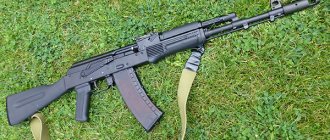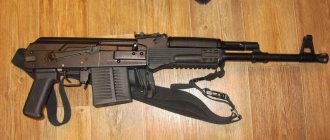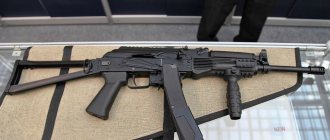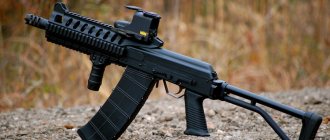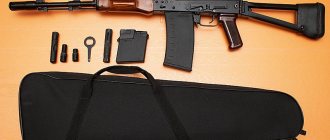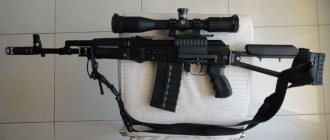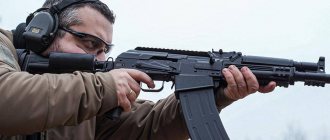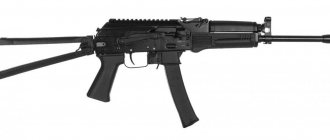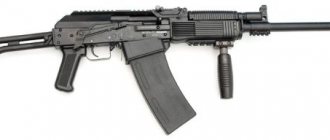In the 70s of the last century, farmers of the Kazakh Republic faced an unexpected misfortune. Vast arable agricultural lands were trampled by migrating herds of saiga antelope, causing colossal losses.
Numerous groups of hunters, armed with shotguns used at that time, were unable to cope with the problem and significantly reduce the animal population. Buckshot charges did not have the desired effect, only increasing the number of wounded animals.
In this regard, the top leadership of the party decided to develop a fundamentally new type of small arms that could change the current state of affairs. This was the beginning of a large family of carbines, called “Saiga”.
Development history
The development of a new type of small arms was carried out on the basis of the production and testing shops of Izhmash. Testing and final development of prototypes was carried out directly in Kazakhstan. As a result of the work carried out, which lasted for four years, the Saiga carbine with the 7.62×39 cartridge was developed and launched into series.
Until the 90s, which were marked by a severe economic crisis, the Saiga carbine was in little demand, and the enterprise was focused on the production of specialized products - the Kalashnikov assault rifle. Perestroika brought the enterprise to the brink of bankruptcy, signaling the need to search for new sources of income. Thus, Izhmash specialists began to carry out work on adapting military technologies for use in the civilian sphere.
Later, due to a sharp reduction in government orders for small arms, production lines were reoriented to the production of weapons for civilian use.
Smoothbore hunting carbine "Saiga"
The first smooth-bore modification of the Saiga carbine for hunting, which appeared in the mid-90s, was designed to fire the then little-known 410 caliber cartridge. In the metric system - 10.4 mm. For this smallest caliber, there are several modifications of the cartridge case.
The standard cartridge, which has a case length of 70 mm, is low-power and is not capable of providing sufficient weight to the projectile. Therefore, the more powerful 410/76 Magnum cartridge is most often used, which provides higher shooting performance, such as weight and bullet speed.
The Saiga 410 caliber smoothbore carbine is ineffective when firing shotguns. This is due to the presence of a small amount of shot in the cartridge. The same applies to shooting with buckshot.
Due to the small caliber and the presence of a smooth barrel, the characteristics of the carbine during bullet shooting are significantly inferior to its rifled counterparts. But, nevertheless, with the right cartridge, the weapon exhibits sharp and accurate action and is excellent for recreational shooting and self-defense.
Saiga rifled hunting weapon
The Saiga rifled carbine, chambered for the 7.62 x 39 caliber cartridge, was developed on the basis of the AKM, copying the appearance and design features. Its main and significant difference from the Kalashnikov assault rifle is the lack of the ability to fire in automatic mode. The trigger mechanism elements responsible for these functions have been removed from the design.
There are also a number of design limitations. Thus, due to differences in the attachment point, it is impossible to insert a magazine from a combat assault rifle into the Saiga hunting carbine.
The stock and fore-end are manufactured in accordance with the standards of hunting weapons. They can be made of plastic, metal, but most often wood. The design of the carbine does not have a pistol grip intended for firing control. As a result, the trigger and guard are located closer to the butt and are additionally equipped with a trigger rod.
The magazine capacity can be five or ten rounds. You can also find models adapted for firing 5.45x39 and .223 rem cartridges.
Rifled carbine Saiga 7.62*39 through the eyes of the owner
The Saiga rifled carbine chambered for 7.62*39 is one of the most common types of rifled hunting weapons in our country. The operating principle of its automation and the internal structure of the carbine are known to almost everyone interested in weapons, because everything in it is built on the basis of a Kalashnikov assault rifle. For this reason, we will not go into this topic, but will talk about the features of the practical use of this weapon for hunting, its pros and cons.
Saiga rifled carbine 7.62*39 – advantages and use for hunting
The rifled Saiga is a convenient, reliable and extremely practical hunter’s tool. It is distinguished by high reliability and great versatility.
Weapon reliability
Speaking of reliability, I can note that during the entire time I used this carbine (the total rounds fired, taking into account training shooting, exceeds 10,000 rounds), I personally did not have a single stick or any other “jamb” with reloading. At the same time, such a statement, oddly enough, does not really apply to the shotgun Saiga, but that’s a separate conversation.
The next thing I would like to note when talking about reliability is the excellent operation of the automation in all weather conditions. Problems, as already mentioned, did not arise either in rain, or in severe frost, or in any other weather. The reloading itself occurs very smoothly (especially in comparison with the same shotgun Saiga).
The versatility of caliber 7.62*39
The second important point that was mentioned is versatility. The 7.62*39 caliber offers a very large number of cartridges with different types of bullets - from full-shell to hollow point. This variety allows you to choose ammunition for almost any type of hunting - from hazel grouse to large ungulates.
Actually, this is, in my opinion, the main advantage of this caliber - it allows you to hunt in the middle zone virtually everything that is allowed to hunt with a rifle (with the exception of elk and bear - in this case larger calibers should be used, even though that many hunt successfully with 7.62*39).
By the way, speaking about the variety of bullets , I can personally note from my own experience that when shooting at small animals (fox, beaver) at close range, hollow-point bullets practically do not open up, that is, in fact, there is not much difference in what exactly to shoot in this case. . And if you run out of FMJ , then it’s quite possible to go hunting with SP - there won’t be much difference in damage to the carcass (but, I repeat, at close range and against small game).
In parallel with high versatility comes the low cost of the cartridge. In fact, this is the most budget cartridge, the price of which is less than other rifled and smoothbore cartridges, not to mention the cost of the now “fashionable” .366TKM cartridges and others like them (if we consider the most affordable ammunition in these categories). This fact is also very important, because with a budget limited to a certain amount of ammunition in caliber 7.62*39, it will be possible to buy, say, more ammunition for training shooting than cartridges of any other caliber. For those who want higher quality cartridges, ammunition from well-known manufacturers (for example, Norma) is also available in the specified caliber. The price of one such cartridge specifically for us is around 100 rubles. I personally have not tried to shoot with these, but those who have tried claim that their accuracy is indeed higher.
Accuracy and accuracy
Actually, the third thing I would like to say is that it has decent accuracy even when firing with standard ammunition. I won’t cite arc minutes and other things here, I just want to note that it was possible to compare the “zero” SKS carbines (4 in number) and Saiga carbines in the same caliber. In all cases, other things being equal, Saiga showed higher accuracy. This, albeit small, is still an argument in favor of this carbine for those who want to purchase a rifled one, but cannot choose.
Working with impact
The fourth thing I would like to mention is the comfortable return. Sometimes I came across that the recoil energy of a given caliber is close to 12, but in reality the difference is obvious. The recoil is extremely comfortable and does not cause any unpleasant sensations not only in winter, but also when shooting in the warm season with a minimum of clothing. When shooting from larger calibers, the recoil becomes more noticeable, which is not always good, especially for novice shooters (in the sense that the “expectation” of unpleasant sensations after a shot really prevents many from accurately shooting from a rifled rifle, I personally know such cases). It is for this reason that I recommend a weapon chambered for this cartridge as a first rifle.
Ergonomics
Among the additional advantages of the Saiga, if we compare it with the SKS carbine, I can name fast loading (after all, attaching a new magazine, and in the cold, is much more convenient than fiddling with the clip, even with sufficient skill), the presence of a side bar for installing a bracket (on SKS it does not always occur) and easier cleaning.
Disadvantages of Saiga 7.62*39
I personally cannot name specific shortcomings or serious problems with this weapon. Moreover, if I were asked which rifle to buy first, I would definitely recommend the Saiga rifled carbine in the specified caliber. There are a lot of reasons for this, and they were given above - starting with the most affordable ammunition and ending with absolute reliability. At the same time, it is worth mentioning a number of small disadvantages inherent in the design itself and the specified ammunition.
Firstly, the 7.62*39 cartridge is far from being a sniper cartridge (or even a rifle cartridge), for this reason it is not worth taking a weapon under it for long-range shooting. Still, other calibers are significantly superior in accuracy and require smaller vertical adjustments for long distances.
Secondly, as already mentioned, for hunting really large game (adult elk and, especially, bear), it is better to take a larger caliber, despite the advice of those who managed to take these animals with weapons chambered for the 39th cartridge (and such there are a lot of advisers).
Thirdly, I have met people who do not like this carbine because it is “military” and not “hunting” (this despite the fact that the SKS does not cause such a reaction in them). Well, here, as they say, to each his own.
Concluding the conversation, I would like to note once again that, perhaps, the Saiga rifled carbine in caliber 7.62*39 is the most versatile domestic rifled hunting weapon and certainly the best option as the first rifle for any hunter.
Specifications
In all modifications of the Saiga, the hunting rifle operates according to a self-loading operation scheme. The powder gases exhausted after the shot and the return spring carry out the work of reloading the cartridge. After which the next shot is carried out by simply pressing the trigger.
Most models are equipped with a barrel length of 520 mm. There are also samples with an elongated barrel - 555 mm, and a shortened one - 415 mm (Saiga-MK carbine). The weight of the weapon with an empty magazine is 3.6-3.9 kg, length is 1,040-1,165 m.
Standard samples are equipped with an aiming bar and a front sight, which can be calibrated in two planes. The aimed shooting distance in this modification is 300 m. The carbine can also be equipped with various optical devices that will not interfere with direct aiming. Depending on the modification, the performance characteristics of the Saiga can vary significantly.
Operating principle
Based on the use of part of the powder gases from the barrel bore, which activate the trigger mechanism.
- The carbine is removed from the safety by lowering its flag, located on the right side of the receiver, down.
- The bolt frame is retracted, for which you need to hook the first phalanx of the index finger of your right hand onto its lever, and then release it so that the bolt frame itself, energetically and with a characteristic click, returns to its original position.
- When the bolt frame is returned, a cartridge from the magazine is sent into the chamber, the bolt rotates and locks the barrel. At the same time, the trigger is cocked and the trigger is placed on the sear hook.
- After pressing the trigger, the trigger is released and strikes the firing pin, the firing pin of which punctures the cartridge primer. A shot occurs.
- When fired, part of the powder gases return to the gas tube and put pressure on the bolt frame piston, forcing it to move back and compress the return mechanism spring. As a result, the trigger is cocked and the cartridge is supplied from the magazine to the loading line.
- When the bolt frame is returned back under the action of the return mechanism spring, actions similar to step 3 occur, after which the carbine is ready for the next shot.
Carbine modifications
Saiga carbines have markings characteristic of all calibers. At the beginning there is a word that indicates belonging to the family - “Saiga”, followed by a letter sign indicating the modification.
There are such weapon modifications as:
- "Saiga-M" is a modernized model with an extended barrel. The bolt has three lugs, the firing mechanism system requires less force for release, and the butt is equipped with a rubber butt plate.
- M1, M2 and the Saiga-M3 carbine are different options for manufacturing the M modification.
- The Saiga-MK carbine is a model with a shortened barrel and a locking mechanism that prevents shooting with the butt folded.
The letter markings are followed by numbers. They indicate the caliber of the weapon.
The following numerical types of markings can be distinguished:
- No index - a carbine designed to fire a standard cartridge - 7.62x39mm.
- Number 223 – cartridge caliber – 5.56x45mm.
- The Saiga-308 carbine allows you to fire a 7.62x51mm cartridge.
- The number 5.6 is the cartridge caliber – 5.6x39mm.
- Number 9 – cartridge caliber 9x53mm or 9x19 Parabellum.
If the carbine has a special design, then an additional index may be indicated through a space. For example: EXP 01 - indicates a modification for police needs.
Design
- Self-loading carbine with folding stock. The trigger mechanism is driven by powder gases discharged from the barrel bore through a gas outlet pipe.
- The design is completely identical to the AK-104 combat assault rifle, the only thing that makes the Saiga MK version 03 different from it is the absence of an automatic fire sear. Provision is made for blocking the trigger when the stock is folded.
- The pistol grip, butt, fore-end and gas tube cover in the basic version are made of black impact-resistant plastic.
- Sights are a traditional AK rear sight-ruler with a slider and a high closed front sight, both made of metal.
Advantages and disadvantages
The Saiga rifled carbine has acquired many features from the Kalashnikov assault rifle; it is often also called the hunting AK. Thanks to its successful design and ease of use, the weapon is highly popular among hunters.
The following advantages can be highlighted:
- The carbine has a low price in comparison with foreign analogues.
- The weapon has the ability, depending on the modification, to be equipped with interchangeable elements, such as the front sight base, forend, butt and others.
- Immediately after the shot, the weapon is automatically reloaded.
- The carbine is equipped with a convenient open-type mechanical sight, allowing effective shooting at a distance of up to three hundred meters. Also, the standard sight does not lose its functions when an optical sight is installed.
- Convenient and reliable safety lock located on the right side of the weapon.
- The barrel and chamber elements are reliably protected from corrosion thanks to chrome coating.
- Ability to use magazines of various capacities.
- The handguard and stock can be made individually. The range of possible materials includes various types of wood and impact-resistant plastic.
Early models often have some shortcomings. Thus, a non-removable flash suppressor can make cleaning the barrel difficult. There may be no markings on the cartridges. The stock may be made of low-quality material.
The Saiga-MK carbine has unfinished ergonomics. The model has an insufficient butt length, which can cause difficulties when hunting. The problem is eliminated by installing a rubber head and cheek. The model also has an inconvenient safety lock.
The Saiga-223 carbine has a shortened barrel, which is not equipped with a flash suppressor. When shooting in the dark, the hunter may be blinded. The trigger is located far away, which reduces the rate of fire.
Despite these shortcomings, the weapon is highly reliable and resistant to breakage and jamming, even if not used properly. In turn, the new Saiga has absorbed all the advantages of previous models, for which it enjoys well-deserved popularity.
Also read
Saiga 12c and 12k shotgun: models, caliber, characteristics. Smoothbore carbine for hunting
Types of Izhevsk hunting rifles: review of types of smooth-bore weapons IZH
Carbine Elk - which one to choose for hunting: Elk 7, 7-1, 9 - technical characteristics
Double-barreled hunting rifle MP 27 (IZH 27): technical characteristics, modifications
Hunting rifle TOZ 34: technical characteristics, modifications, hunting with TOZ
SKS (Simonov self-loading carbine): technical characteristics, shooting, disassembly
Hunting carbine "Vepr": characteristics of smooth-bore and rifled models. Vepr 12, hunter, super
Review of the self-loading rifled carbine Saiga 9 (9×19) from the Kalashnikov concern, Izhevsk
Procedure for partial disassembly
- Separate the magazine from the receiver.
- Remove the cleaning rod.
- Recess the corrugated square button on the receiver cover and separate it itself by moving it up and back.
- By pressing forward, remove the return mechanism clutch from the grooves and remove it together with the spring from the groove of the bolt frame.
- Move the bolt carrier back. After the piston exits the gas tube, smoothly, avoiding the stops of the bolt cylinder catching on the guides on the receiver, remove it moving backwards and upwards.
- Remove the bolt cylinder from the bolt frame by tilting it down and turning the bolt clockwise.
